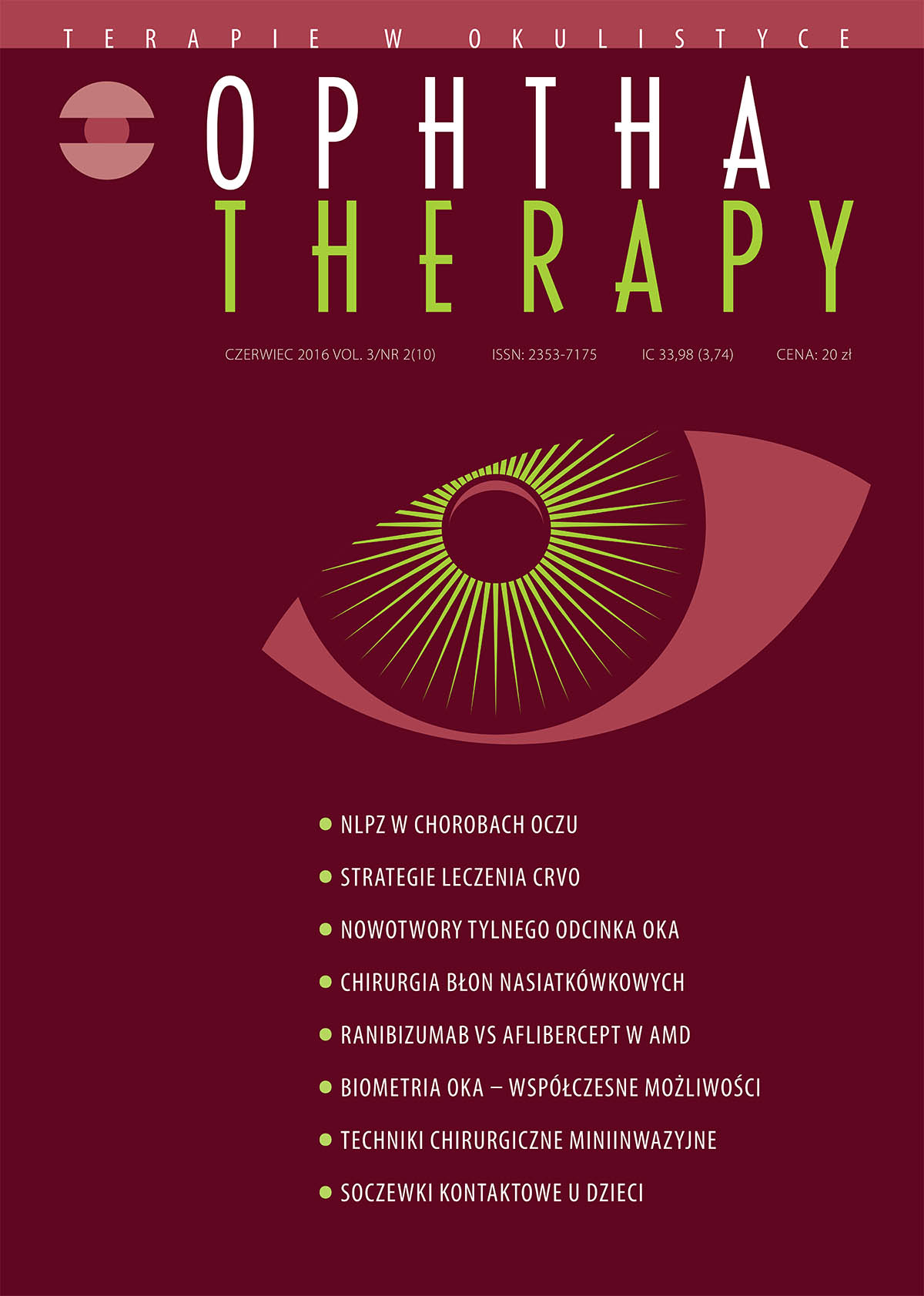Current technologies of ocular biometry
Main Article Content
Abstract
Cataract surgery is currently the most frequently performed surgical procedure in developed countries. In some cases it is also regarded as refractive procedure, and the use of premium intraocular lenses (aspheric, toric, multifocal) allows the patient to become spectacle independent. The improvement of surgical treatment results in rising expectations of patients. The key issue is to achieve the desired refractive outcome. Essential for this purpose are precise measurements of the eye, and selection of the optimal IOL calculation formula. The aim of this paper is to present current techniques of ocular biometry and new biometry devices available in Poland, along with a comparison of their functions. Good understanding the advantages and limitations of the current technology allows to perform measurements efficiently and to achieve highly accurate refractive outcomes.
Downloads
Article Details

This work is licensed under a Creative Commons Attribution-NonCommercial-NoDerivatives 4.0 International License.
Copyright: © Medical Education sp. z o.o. License allowing third parties to copy and redistribute the material in any medium or format and to remix, transform, and build upon the material, provided the original work is properly cited and states its license.
Address reprint requests to: Medical Education, Marcin Kuźma (marcin.kuzma@mededu.pl)
References
2. Zheng L, Merriam JC, Zaider M. Astigmatism and visual recovery after ‘large incision’ extracapsular cataract surgery and ‘small’ incisions for phakoemulsification. Trans Am Ophthalmol Soc. 1997; 95: 387-410.
3. Basic and Clinical Science Course, Section 3: Clinical Optics (2011–2012 ed). American Academy of Ophthalmology: 211-23.
4. Ossoinig KC. Standardized echography: basic principles, clinical applications, and results. Int Ophthalmol Clin. 1979; 19: 127-210.
5. Schelenz J, Kammann J. Comparison of contact and immersion technique for axial length measurement and implant power calculation. J Cataract Refract Surg. 1989; 15: 425-8.
6. Shammas HJF. A comparison of immersion and contact techniques for axial length measurements. J Am Intraocular Implant Soc. 1984; 10: 444-7.
7. Olsen T, Nielsen PJ. Immersion versus contact technique in the measurement of axial length by ultrasound. Acta Ophthalmol. 1989; 67: 101-2.
8. Lee AC, Qazi MA, Pepose JS. Biometry and intraocular lens power calculation. Curr Opin Ophthalmol. 2008; 19(1): 13-7.
9. Grzybowski A, Gaca-Wysocka M. Współczesna wiedza na temat soczewki. Przegl Okul. 2014; 4: 1-4.
10. Behndig A, Montan P, Lundström M et al. Gender differences in biometry prediction error and intra-ocular lens power calculation formula. Acta Ophthalmol. 2014; 92(8): 759-63.
11. Srivannaboon S, Chirapapaisan C, Chonpimai P et al. Clinical comparison of a new swept-source optical coherence tomography-based optical biometer and a time-domain optical coherence tomography-based optical biometer. J Cataract Refract Surg. 2015; 41(10): 2224-32.
12. Ventura BV, Al-Mohtaseb Z, Wang L et al. Repeatability and comparability of corneal power and corneal astigmatism obtained from a point-source color light-emitting diode topographer, a Placido-based corneal topographer, and a low coherence reflectometer. J Cataract Refract Surg. 2015; 41(10): 2242-50.
13. Huang J, Savini G, Wu F et al. Repeatability and reproducibility of ocular biometry using a new noncontact optical low-coherence interferometer. J Cataract Refract Surg. 2015; 41(10): 2233-41.
14. Chen YA, Hirnschall N, Findl O. Evaluation of 2 new optical biometry devices and comparison with the current gold standard biometer. J Cataract Refract Surg. 2011; 37(3): 513-7.
15. Aktas S, Aktas H, Tetikoglu M et al. Refractive Results Using a New Optical Biometry Device: Comparison With Ultrasound Biometry Data. Medicine (Baltimore). 2015; 94(48): e2169.
16. Kaswin G, Rousseau A, Mgarrech M et al. Biometry and intraocular lens power calculation results with a new optical biometry device: comparison with the gold standard. J Cataract Refract Surg. 2014; 40(4): 593-600.
17. Vogel A, Dick HB, Krummenauer F. Reproducibility of optical biometry using partial coherence interferometry: intraobserver and interobserver reliability. J Cataract Refract Surg. 2001; 27(12): 1961-8.
18. Hennessy MP, Chan GD. Contact versus immersion biometry of axial length before cataract surgery. J Cataract Refract Surg. 2003; 29: 2195-8.
19. Dmitriew A, Załęcki K, Kocięcki J. Implementacja biometrii optycznej w okulistyce – fakty i mity. Ultrasonografia. 2006; 26: 29-32.

